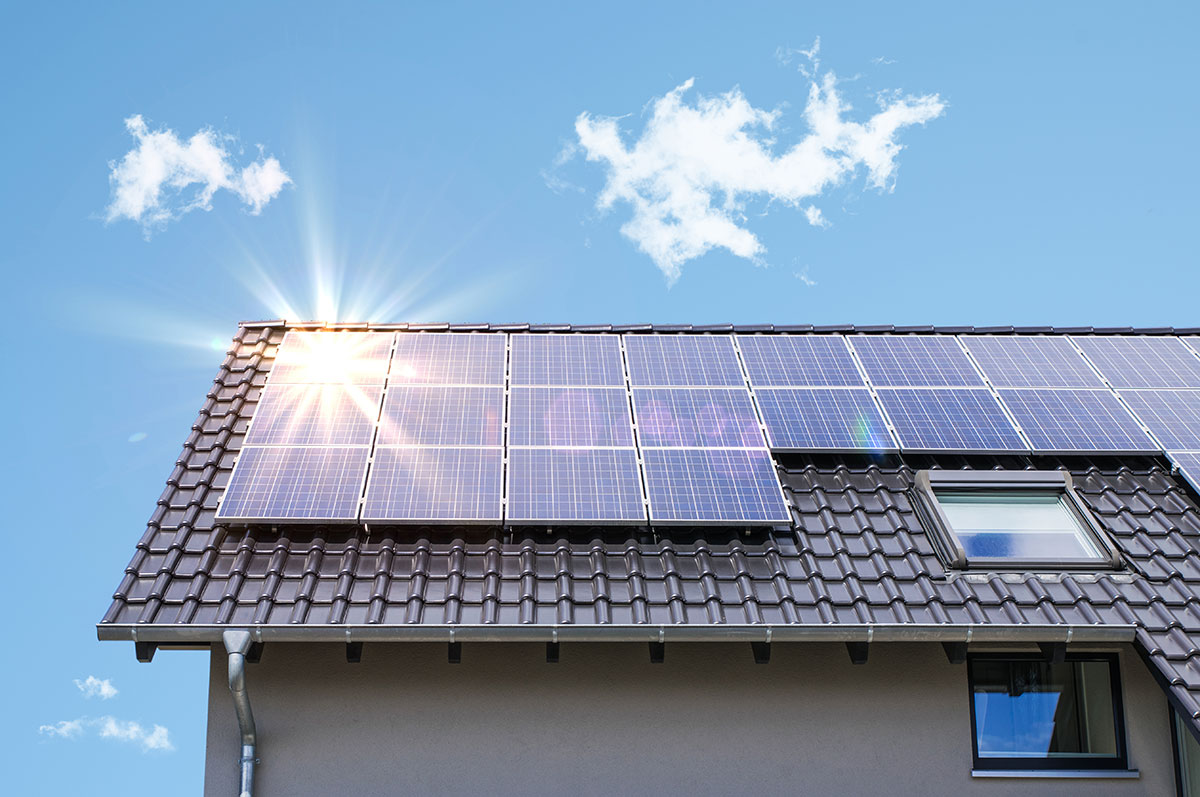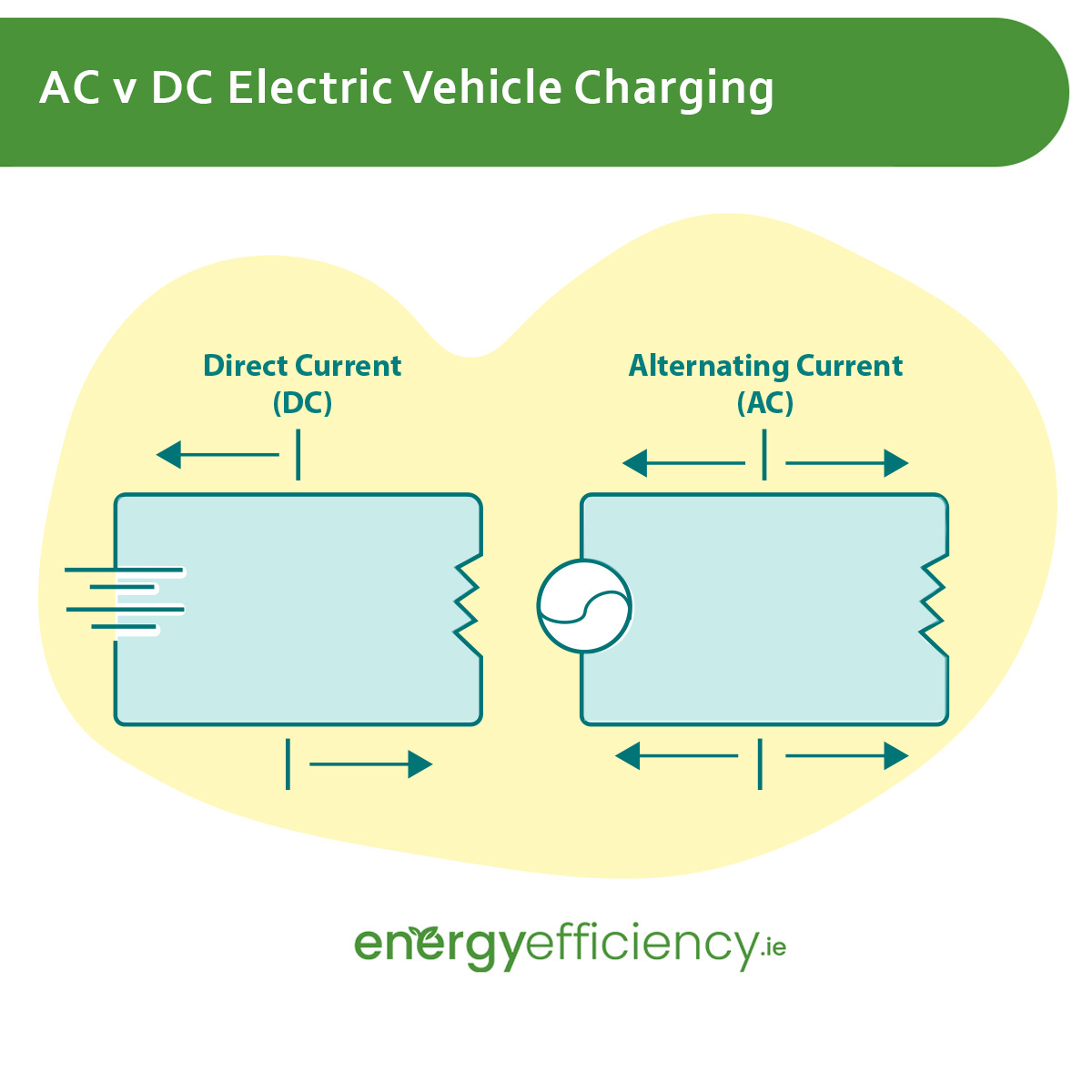
AC v DC Electric Vehicle Charging

Written by
Briain Kelly
Last edited
27/07/2024
Speed is one of the biggest things people think about in relation to charging an electric car. Just how fast will this charger work?
This is an important question since it is impractical to spend two or more hours at a public charging station just to get a slight top of a portion of your battery.
A big part of the answer to this question isn’t just the wattage of the charger, but whether it is an AC or DC charging station.
While most people will look at the various power outputs of a charger, 7kW or 22kW at home up to 50kW – 350kW for public rapid charging stations.
Table of content
What’s the Difference between AC and DC Electricity
Direct Current (DC) maintains a contant flow in one direction, whilst Aternating Current (AC) changes direction many times each second.
The most important thing for us is that power is distributed through the grid in the form of AC because of the ability to increase or decrease its voltage with a transformer.
This allows for it to be sent long distances along power lines at high voltage, resulting in very little energy lost, before the voltage is reduced closer to its destination before being sent to homes and businesses.
However, batteries can only store direct current electricity. This means that any power being sent to an EV Battery will have to be converted to DC before being stored.
AC and DC Electric Car Charging
The biggest difference between AC and DC changing is where the conversion of the electricity takes place, and this has a big impact on charge speeds.
When using an AC charger the electricity is converted to DC by the ‘onboard charger’, which then sends that power on to the battery via the Battery Management System.
With a DC charger the conversion from AC to DC electricity takes place within the charger. As these are larger units the conversion happens more efficiently and rapidly. This allows for charging speeds well in excess of AC units.
Home EV Charging
A home EV charger is typically a wall-mounted box which draws power directly from your home grid. Typically with a power output of 7kW, 11kW, or 22kW for the fastest models, these chargers make use of the same AC electricity which is present in the power grid.
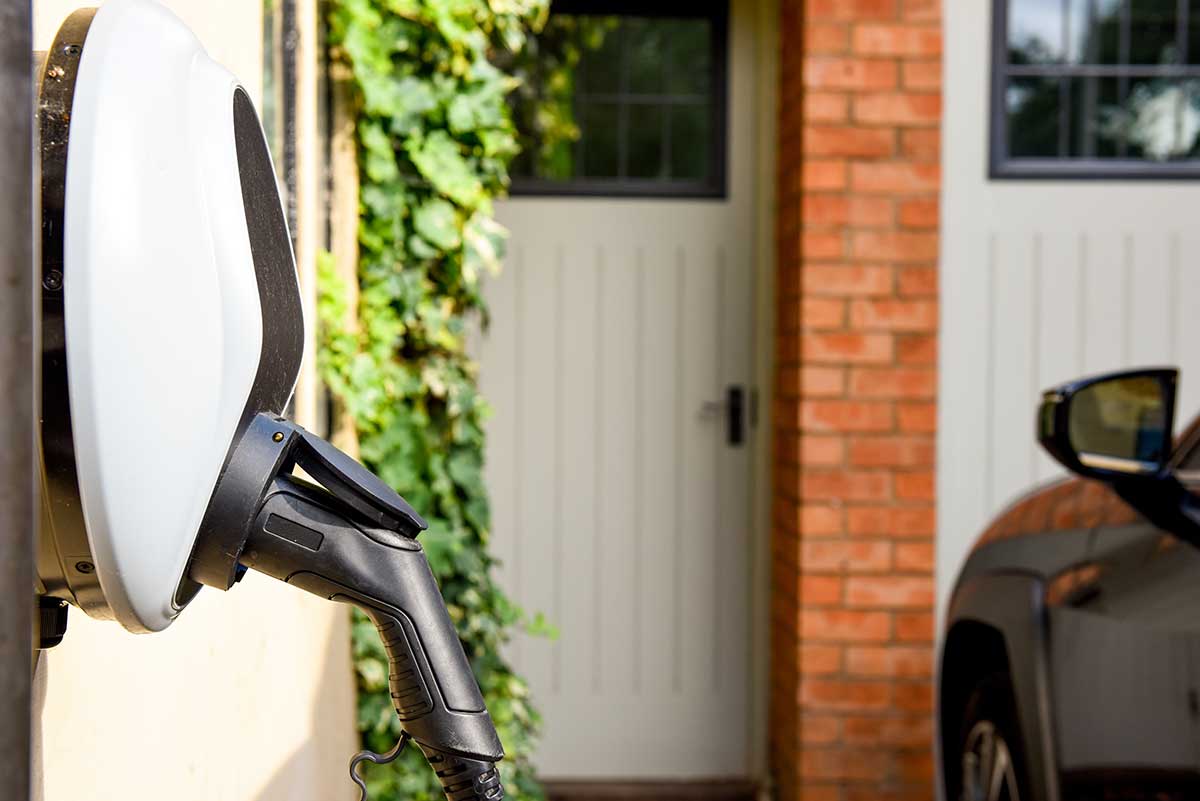
EV Fast Charging
Fast charging stations, which typically range from 50-350kW in strength, are found at fuel stations and other select locations around the country.
Resembling fuel pumps in size they offer a much more rapid charging than home chargers, but will also cost more than charging at home.
EV Charging Speeds
There is a vast difference in the speed between how fast AC and DC charging stations can fill your battery, and in how they do so.
AC chargers offer a steady flow of electricity which brings the battery up to 100% charge at a constant, if slower pace.
DC charging stations will offer a far more rapid flow of power at first, but this slows down as the battery approaches capacity.
This is why most rapid charging stations will speak about how quickly they can reach 80% capacity, as the charge slows to a trickle after this point.
| Charger Type | Charge Time | Battery Level |
| 7kW AC Charger | 6 – 8 hours | 100% |
| 22kW AC Charger | 4 – 6 hours | 100% |
| 50kW DC Charger | ~30 mins | 80% |
| ≥ 150kW DC Charger | ~5 – 10 mins | 80% |
EV Charging Costs
There is a vast difference in price between AC and DC charging when you consider that most AC charging is done at home, while most DC charging takes place at public filling stations.
| Charger Type | Cost €/kWh |
| Home Charger (AC) | Night: €0.1783/kWh |
| Night Boost: €0.1047/kWh | |
| Fast Charger 22kW – 100kW (DC) | €0.647/kWh |
| High Power Charger ≥ 150kW | €0.682/kWh |
Home Electricity Prices based on Electric Ireland Home Electric+ Night Boost tariffs. Fast Charging figures based on ESB ecars Pay as You Go Price Plan
The Future of Fast EV Charging
The majority of home EV chargers are still maxing out at 22kW AC chargers, and most DC fast charging stations still come into the form of 50-150kW units which are the size of fuel pumps.
However, there is movement towards smaller, more compact DC charging stations. Already there are 25-30kW fast charging stations on the market which take the form of bulkier wall-mounted or pole-mounted charging stations.
These take up more space than existing home chargers, but what they lack in elegance they make up for in efficiency.
EV Charging Infrastructure
Ireland is also finally starting to make inroads on the necessary infrastructure for public electric vehicle charging stations along the main motorway routes in the country.
A €21 million grant scheme aims to install a pool of high speed chargers every 60km along Ireland’s motorway network by the end of 2025.
These charging station pools are meant to have a combined power output of 1,200kW, with at least four 150kW charging points in each pool.
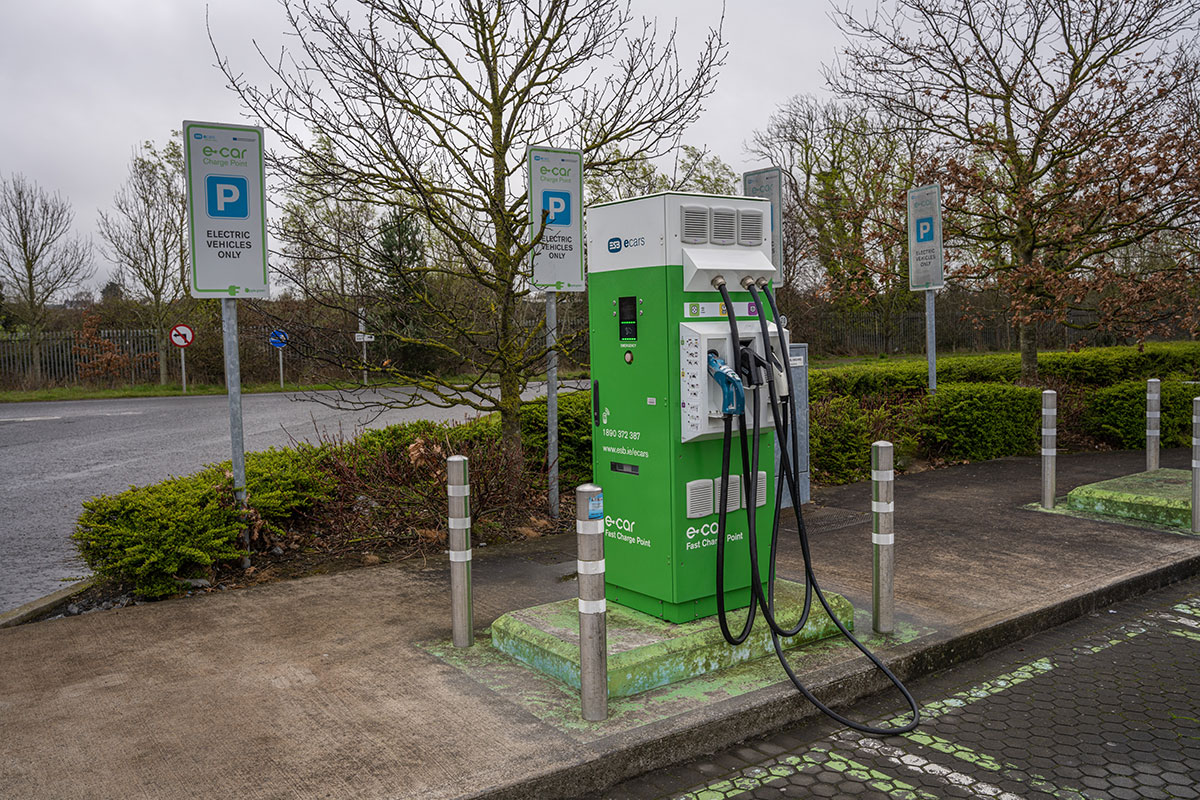
FAQs
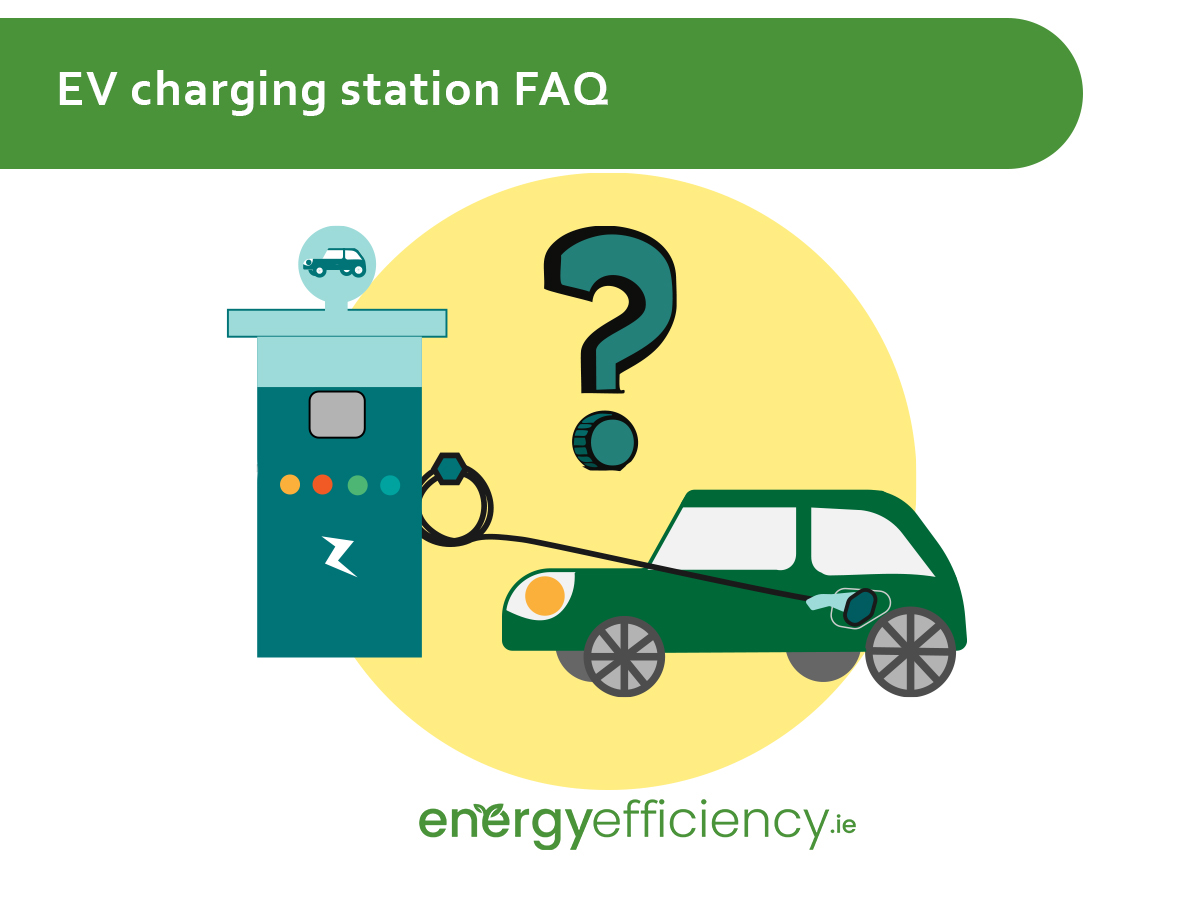
Get a EV Charging station for your home or business
Speak to Energy Efficiency today to get the best quotes on the market for EV charging stations for your home or business.
Speak with Ireland’s leading source of home energy to find out how much you could save on your home or businesses energy bills today.

Author:

Briain Kelly
RENEWABLE ENERGY RESEARCHER
Briain Kelly is a Leinster based journalist and content creator who has been writing about energy efficiency and renewable energy technologies for nearly three years. He researches the latest news in multiple areas related to solar power, electric vehicles, heat pumps, and home energy upgrades. His writing includes both technological developments and government policy.
Author:

Briain Kelly
Renewable Energy Researcher
Briain Kelly is a Leinster based journalist and content creator who has been writing about energy efficiency and renewable energy technologies for nearly three years. He researches the latest news in multiple areas related to solar power, electric vehicles, heat pumps, and home energy upgrades. His writing includes both technological developments and government policy.
AC v DC Electric Vehicle Charging
Written by
Briain Kelly
Last edited
27/07/2024
Speed is one of the biggest things people think about in relation to charging an electric car. Just how fast will this charger work?
This is an important question since it is impractical to spend two or more hours at a public charging station just to get a slight top of a portion of your battery.
A big part of the answer to this question isn’t just the wattage of the charger, but whether it is an AC or DC charging station.
While most people will look at the various power outputs of a charger, 7kW or 22kW at home up to 50kW – 350kW for public rapid charging stations.
Table of content
What’s the Difference between AC and DC Electricity
Direct Current (DC) maintains a contant flow in one direction, whilst Aternating Current (AC) changes direction many times each second.
The most important thing for us is that power is distributed through the grid in the form of AC because of the ability to increase or decrease its voltage with a transformer.
This allows for it to be sent long distances along power lines at high voltage, resulting in very little energy lost, before the voltage is reduced closer to its destination before being sent to homes and businesses.
However, batteries can only store direct current electricity. This means that any power being sent to an EV Battery will have to be converted to DC before being stored.
AC and DC Electric Car Charging
The biggest difference between AC and DC changing is where the conversion of the electricity takes place, and this has a big impact on charge speeds.
When using an AC charger the electricity is converted to DC by the ‘onboard charger’, which then sends that power on to the battery via the Battery Management System.
With a DC charger the conversion from AC to DC electricity takes place within the charger. As these are larger units the conversion happens more efficiently and rapidly. This allows for charging speeds well in excess of AC units.
Home EV Charging
A home EV charger is typically a wall-mounted box which draws power directly from your home grid. Typically with a power output of 7kW, 11kW, or 22kW for the fastest models, these chargers make use of the same AC electricity which is present in the power grid.

EV Fast Charging
Fast charging stations, which typically range from 50-350kW in strength, are found at fuel stations and other select locations around the country.
Resembling fuel pumps in size they offer a much more rapid charging than home chargers, but will also cost more than charging at home.
EV Charging Speeds
There is a vast difference in the speed between how fast AC and DC charging stations can fill your battery, and in how they do so.
AC chargers offer a steady flow of electricity which brings the battery up to 100% charge at a constant, if slower pace.
DC charging stations will offer a far more rapid flow of power at first, but this slows down as the battery approaches capacity.
This is why most rapid charging stations will speak about how quickly they can reach 80% capacity, as the charge slows to a trickle after this point.
| Charger Type | Charge Time | Battery Level |
| 7kW AC Charger | 6 – 8 hours | 100% |
| 22kW AC Charger | 4 – 6 hours | 100% |
| 50kW DC Charger | ~30 mins | 80% |
| ≥ 150kW DC Charger | ~5 – 10 mins | 80% |
EV Charging Costs
There is a vast difference in price between AC and DC charging when you consider that most AC charging is done at home, while most DC charging takes place at public filling stations.
| Charger Type | Cost €/kWh |
| Home Charger (AC) | Night: €0.1783/kWh |
| Night Boost: €0.1047/kWh | |
| Fast Charger 22kW – 100kW (DC) | €0.647/kWh |
| High Power Charger ≥ 150kW | €0.682/kWh |
Home Electricity Prices based on Electric Ireland Home Electric+ Night Boost tariffs. Fast Charging figures based on ESB ecars Pay as You Go Price Plan
The Future of Fast EV Charging
The majority of home EV chargers are still maxing out at 22kW AC chargers, and most DC fast charging stations still come into the form of 50-150kW units which are the size of fuel pumps.
However, there is movement towards smaller, more compact DC charging stations. Already there are 25-30kW fast charging stations on the market which take the form of bulkier wall-mounted or pole-mounted charging stations.
These take up more space than existing home chargers, but what they lack in elegance they make up for in efficiency.
EV Charging Infrastructure
Ireland is also finally starting to make inroads on the necessary infrastructure for public electric vehicle charging stations along the main motorway routes in the country.
A €21 million grant scheme aims to install a pool of high speed chargers every 60km along Ireland’s motorway network by the end of 2025.
These charging station pools are meant to have a combined power output of 1,200kW, with at least four 150kW charging points in each pool.

FAQs

Get a EV Charging station for your home or business
Speak to Energy Efficiency today to get the best quotes on the market for EV charging stations for your home or business.
Speak with Ireland’s leading source of home energy to find out how much you could save on your home or businesses energy bills today.

Author:

Briain Kelly
RENEWABLE ENERGY RESEARCHER
Briain Kelly is a Leinster based journalist and content creator who has been writing about energy efficiency and renewable energy technologies for nearly three years. He researches the latest news in multiple areas related to solar power, electric vehicles, heat pumps, and home energy upgrades. His writing includes both technological developments and government policy.
Author:

Briain Kelly
Renewable Energy Researcher
Briain Kelly is a Leinster based journalist and content creator who has been writing about energy efficiency and renewable energy technologies for nearly three years. He researches the latest news in multiple areas related to solar power, electric vehicles, heat pumps, and home energy upgrades. His writing includes both technological developments and government policy.

